Golf Tips for Beginners: Everything You Need to Know to Get Started
Our essential golf tips for beginners, packed with tips from three top coaches, covers everything you need to get started on your glorious golfing journey...


Golf tips for beginners are the building blocks of a lifelong passion. We know it might feel daunting at first, navigating through the jargon and etiquette of a sometimes complicated sport, but establishing a strong foundation of clear fundamentals will inevitably lead to increased enjoyment and greater improvement.
This article aims to guide you through everything you need to know in order to start your own golfing journey. By focusing on the best golf tips from core elements of the game, like nailing the perfect golf grip and the correct ball position with every club, we are confident that this guide will help you to build your golf swing and set you up to fulfil your potential on the golf course.
Golf Tips for Beginners
In order to set you up to excel on your journey into golf, I have collated some of the best beginner golf tips from a selection of our prestigious Golf Monthly Top 50 Coaches. Before we get into that, however, I have shared some advice on how to get the right equipment to enable you to get onto the golf course as quickly as possible.
1. Equipment
Getting the right equipment to kick start your participation in golf can feel like a tricky and sometimes terrifying process, especially when you consider the sheer volume of golf gear available on the market at any one time.
Listening to the advice of experts in the field is a great way to ensure you don’t make any mistakes that will harm your progress and your wallet, which is where we come in. Golf Monthly’s team of dedicated gear experts have tested an impressive range of the best golf club sets for beginners, highlighting everything you need to know in order to reach your golfing goals.
What can I expect to get in a beginner golf club set?
Most beginner golf club sets will include all of the essentials, including a driver, a fairway wood or hybrid, a set of irons, a wedge/set of wedges and a putter. These clubs have different roles on the course, typically falling into the following categories:
- Driver - used for tee shots on par-4 and par-5 holes
- Fairway woods and hybrids - used for tee shots on shorter par-4 holes or long par-3 holes, as well as on approach to the green.
- Irons - used for tee shots on par-3 holes as well as most approach shots into the green.
- Wedges - used around the green and in the bunkers
- Putter - used on the green to stroke the ball into the hole
But, why is a golf club set better for beginners than purchasing each club individually?
Subscribe to the Golf Monthly newsletter to stay up to date with all the latest tour news, equipment news, reviews, head-to-heads and buyer’s guides from our team of experienced experts.
Typically, a package can be more cost effective than the alternate option, and they are also far more convenient allowing you to get everything you need for a trip to the golf course in just one purchase.
Many of the golf club package sets are designed with beginners in mind, offering equipment with increased forgiveness and intelligent technology to help you make progress in the game from day one. The consistency of using the same manufacturer and models will also afford a little extra comfort when swinging the club, providing a little familiarity while also looking great in your bag.
Simply put, making an informed decision on your equipment early on in your golfing journey could be the difference between a long-term love of the game and an early exit borne out of frustration and despair. So, try not to feel overwhelmed, we are here to help you.
2. Fundamentals
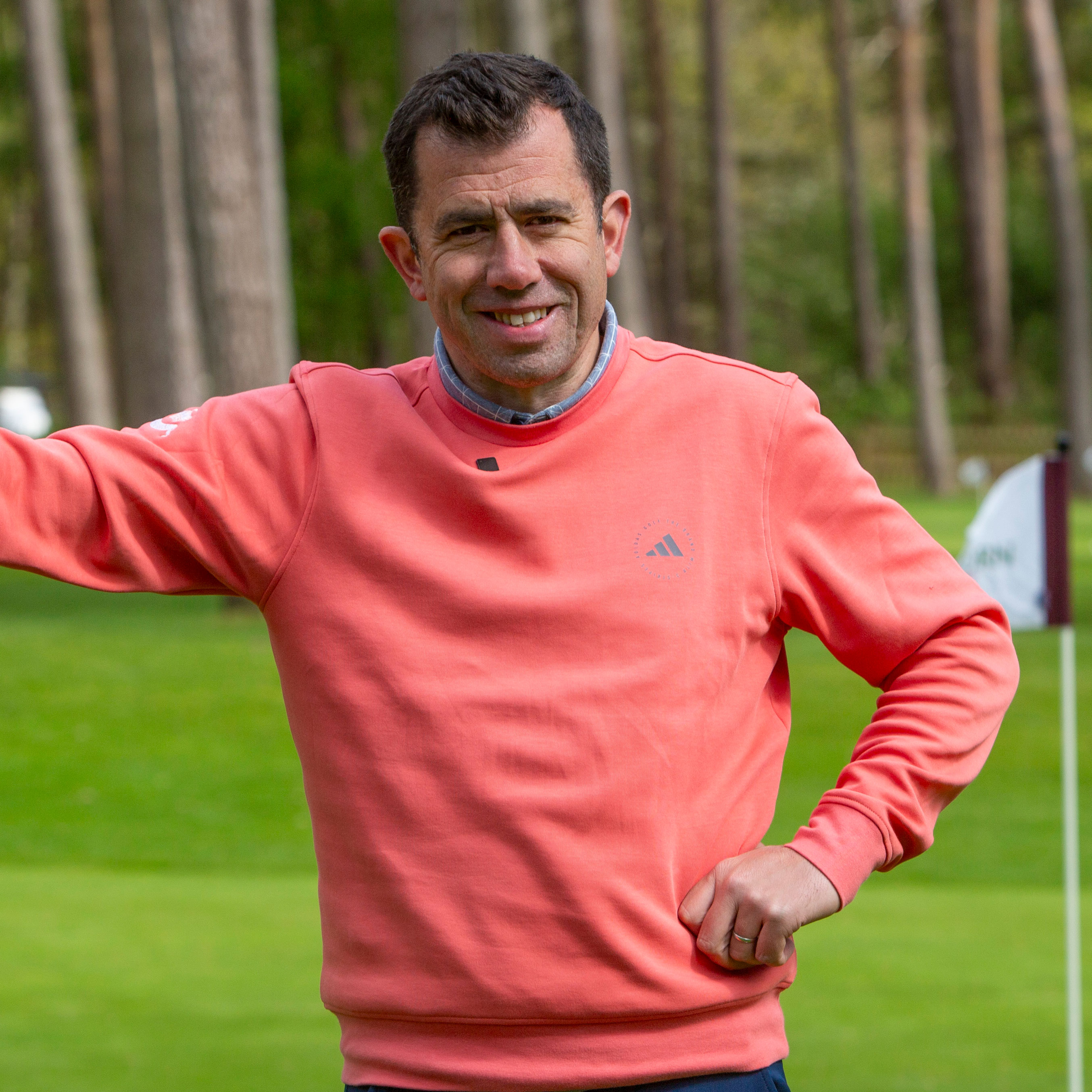
Dan is one of the leading coaches in the UK, a Fellow of the PGA and a short-game virtuoso. He has had considerable success with a collection of tour pros, helping them to Order of Merit titles and Major victories, and his Short Game School is the most attended in the UK. His students, past and present, include Charley Hull, Georgia Hall, Inci Mehmet and Iona Stephen.
Grip
This can save you plenty of shots on the golf course, so finding a nice neutral grip on the club is key. The grip is your only point of contact with the golf club, so it’s super important to spend time bedding this in.
Place your lead hand on the grip of the club, with your thumb pointing down the right centre of the grip (for right-handed golfers). If you are a left-handed golfer, do the same but opposite.
The ‘v’ shape created by your thumb and index finger when your lead hand is on the club needs to ideally point towards your trail shoulder. This is a great reference point to check before each swing. Place your trail hand on top so it’s comfortable and check the ‘v’ points towards the right side of your chest - as you can see in the image.
Finally, interlock the pinky finger on your trail hand through the gap between the index and middle finger on your lead hand to bring it all together. If you prefer, you can just rest the pinky on top of the same gap, which is something called an overlap grip.

Achieving a neutral golf grip is crucial for consistent ball striking
Stance and Posture
I am often asked by amateurs, how wide should my golf stance be? The key is actually to create a strong, athletic posture, as this is important in order to get a consistently clean strike on the golf ball.
Start by standing up straight with your feet around shoulder-width apart. Grab a club, say a 7-iron for example, and hold it out in front of you so that the butt of the grip is pointing at your belly button. Also, be sure to use the grip which I outlined above.
Next, bend at the hips until the head of the club touches the ground. This will give you a good indication of how far to stand from the golf ball. Flex your knees a little and you should find yourself in a similar position to the one I am adopting in the image below.
Depending on the shot you are trying to hit, and the club you have selected, your stance width might change slightly. The driver is a longer club, so needs a wider stance to maintain balance, while a wedge or a 9-iron is a shorter club so your feet can be narrower. For any shot, try to ensure your toes aren’t turned in as this will restrict your movement. You could try instead to flare your lead foot out which will help you turn through the shot.
Ball Position
The ball position in relation to your stance is also key to promote a solid strike. If you have a short- or mid-iron, the ball should be roughly around the centre of your stance. As you work up through your long-irons, into your fairway woods and hybrids, move the ball steadily forward until it’s roughly in line with your lead heel when you have the driver in hand.
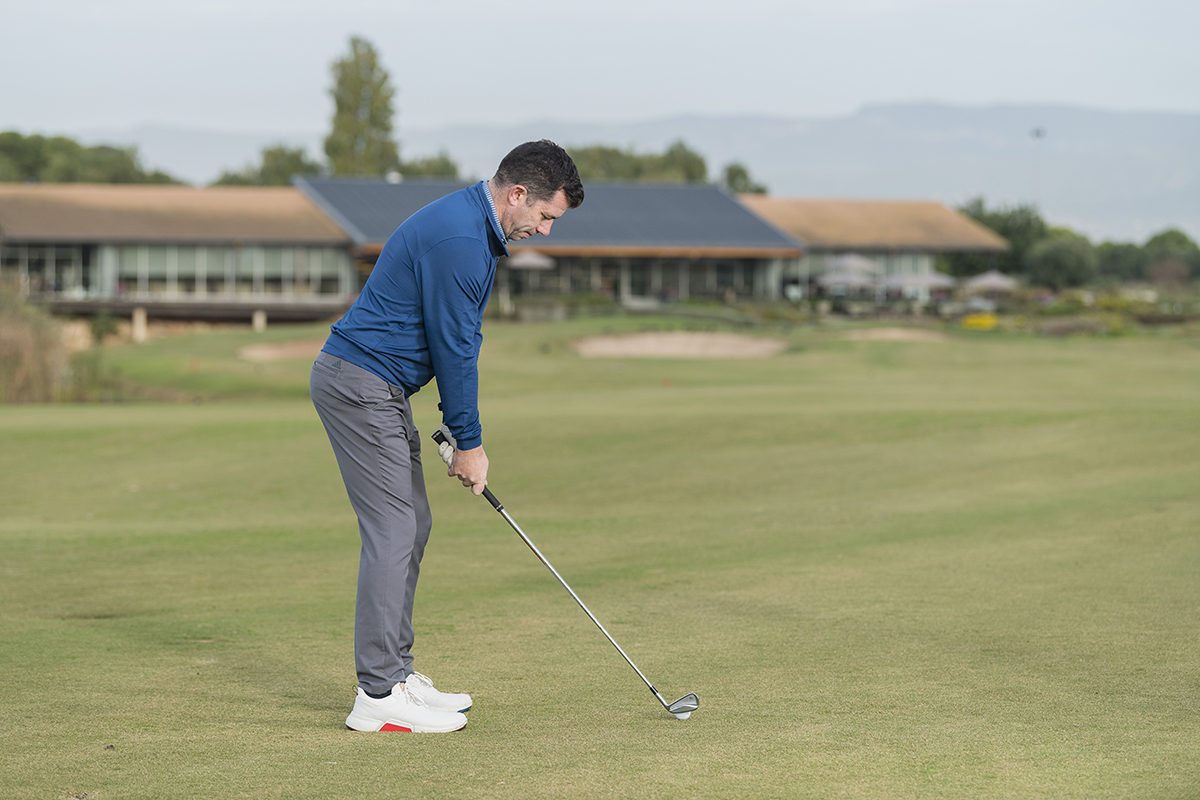
This posture and stance will help to give you the best chance of success when swinging the golf club
3. Golf Swing

Anders Mankert is the owner and head professional at Leicester Golf Centre, with a coaching career spanning more than 28 years.
In 2024, Anders received the title of Master PGA Professional - becoming only the 65th person in history to be awarded that accolade. His vast coaching experience has transformed the golf swing of many amateurs and professionals, while also striving to grow the game through his revolutionary work at Leicester Golf Centre.
Once you have nailed the setup fundamentals, as outlined above, it’s then time to focus on how to swing the golf club. There are a number of nuances and some clear differentiations between the golf swing with a driver in comparison to a wedge or a putter, so for the purpose of this section I am going to focus on the driver.
If you want further information on how to adapt the swing for different clubs and scenarios, Golf Monthly has dedicated articles for each key area in their handy beginners golf guide.
The Backswing
The driver backswing is the power-storing stage of the golf swing. Take your normal setup and address the golf ball. Ensure the ball position is left of your sternum, and that you have a nice wide stance.
Bring the clubhead away from the ball, slowly at first, keeping it very low to the ground in the initial stages. This is called the takeaway, and is the first phase of the backswing. Some new golfers tend to pick the clubhead up quickly, which can lead to problems in the later stages of the swing.
Continue to maintain width in the swing, keeping your left arm straight and feeling as though your hands are as far away from your body as possible. As we swing the club back we need to rotate our body in order to generate power and keep the club moving in the correct way.
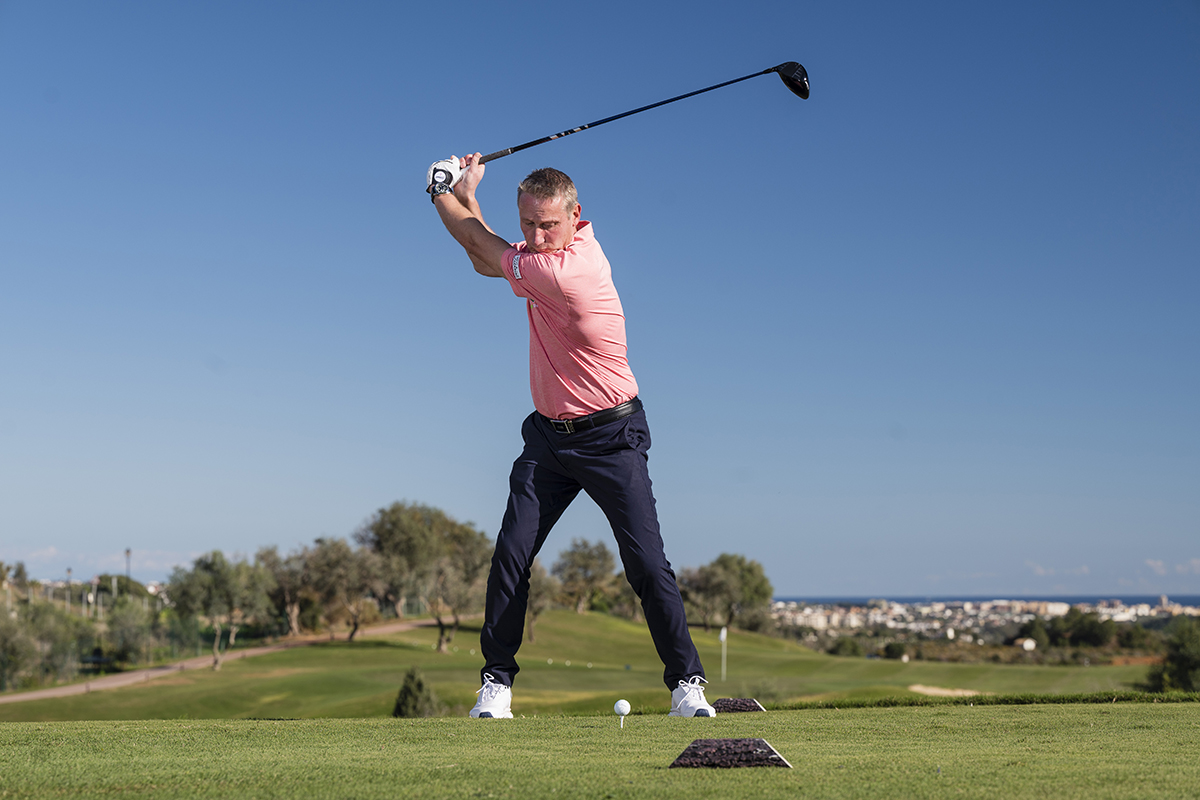
Load the weight into your trail heel and get your lead shoulder over your trail knee
As the club moves away from you in the backswing, transfer your weight onto your trail foot (furthest away from the ball) and try to get your lead shoulder to sit on top of your trail knee. This might feel a little uncomfortable at first, but this helps us to generate maximum power in the golf swing.
Keep your weight on your trail heel until the start of the downswing, and maintain a stable base throughout by adding a little flexion into your knees. Your shoulders will turn a lot more than your hips, and you must ensure your sternum stays behind the ball at this stage of the swing.
The Downswing and Impact
As you start to reach the top of the backswing, it’s now time to initiate the driver downswing. Transfer your weight from the inside of your trail heel to the ball of your lead foot, creating an explosive movement which sends your stored power towards the target.
The swing moves from very wide in the backswing to very narrow in the downswing, so ensure your trail elbow moves towards your body and almost sits in next to your rib cage on the trail side. From this position, you are free to rotate through to impact by clearing your hips and allowing the hands to whip through.
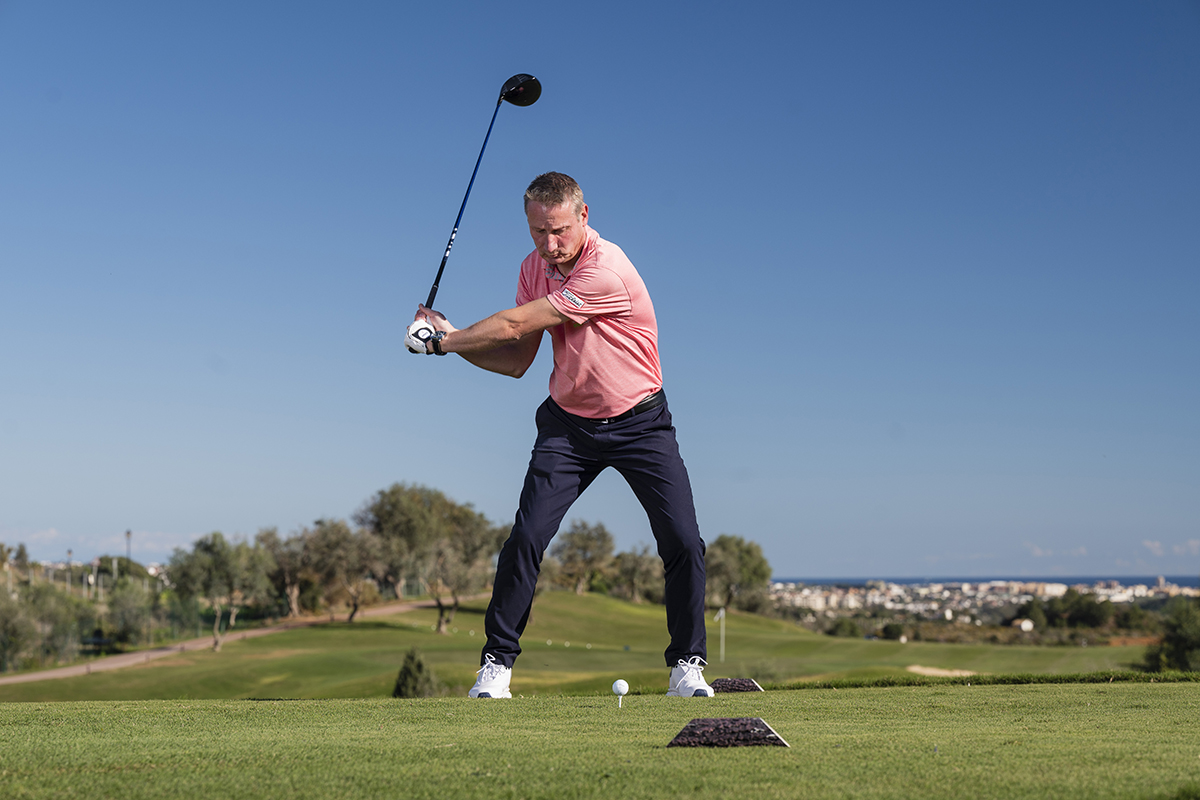
The swing goes from wide to narrow as your transition from the backswing to the downswing with driver
Allow your forearms to rotate through as you release the club through the driver impact position, much like the feeling of throwing a rugby ball, as this will help to prevent the club face from staying open and causing a big slice.
This golf swing is such a vast topic, with so many different points to consider, so covering everything in one article would be very difficult. This is a concise beginners guide that I hope will help you to get started, but be sure to regularly give yourself an MOT by using the best golf tips at Golf Monthly or booking in for a lesson with your local PGA pro.
4. Practice

After turning professional, Rick worked at The Mere in Knutsford before moving to Trafford Golf Centre. It was here where the PGA professional started to film the majority of his content, and his YouTube channel now has over two million subscribers.
As well as offering tips and drills, he's an equipment and golf course fanatic, which sees him create a wonderful variety of content for his growing audience. You can listen to Rick, too, with a new episode dropping every Tuesday on the Rick Shiels Golf Show Podcast.
Putting aside time to practice is crucial for all golfers, no matter their ability, but for beginner golfers it might just be the best investment in your pursuit for progress. Many amateur golfers struggle to find time among their busy schedules, and some that do find a spare slot end up wasting it by arriving without a plan.
When I manage to find 30-minutes to get to the range, I like to break my session up into three 10-minute sections in order to make the most of my time. Below, I will share with you how to implement this routine and share a few tips to help you shoot lower scores on the course.
Section 1: The Basics
This is a hit among tour professionals, so it’s definitely something worth copying. Take two long irons out of your bag, or two alignment sticks if you have them, and place them on the ground so that one points directly to the target and on points at ninety degrees across that first one to create a perfect right angle.
This drill helps with alignment and ball position, giving you a method to check each before hitting every shot. Clearly, you won’t have the clubs on the ground as a reference on the course, but through regular practice this will just become natural.
Hit a few shots with one of your wedges, ensuring your feet are parallel to the target line and the ball position is central. Move up through your bag, moving the ball position slightly forward as you work up to the driver, and start to get a feel for how to set up a strong address position.
Use the remainder of this ten minutes to work on technique. You could even record yourself to get some additional feedback.
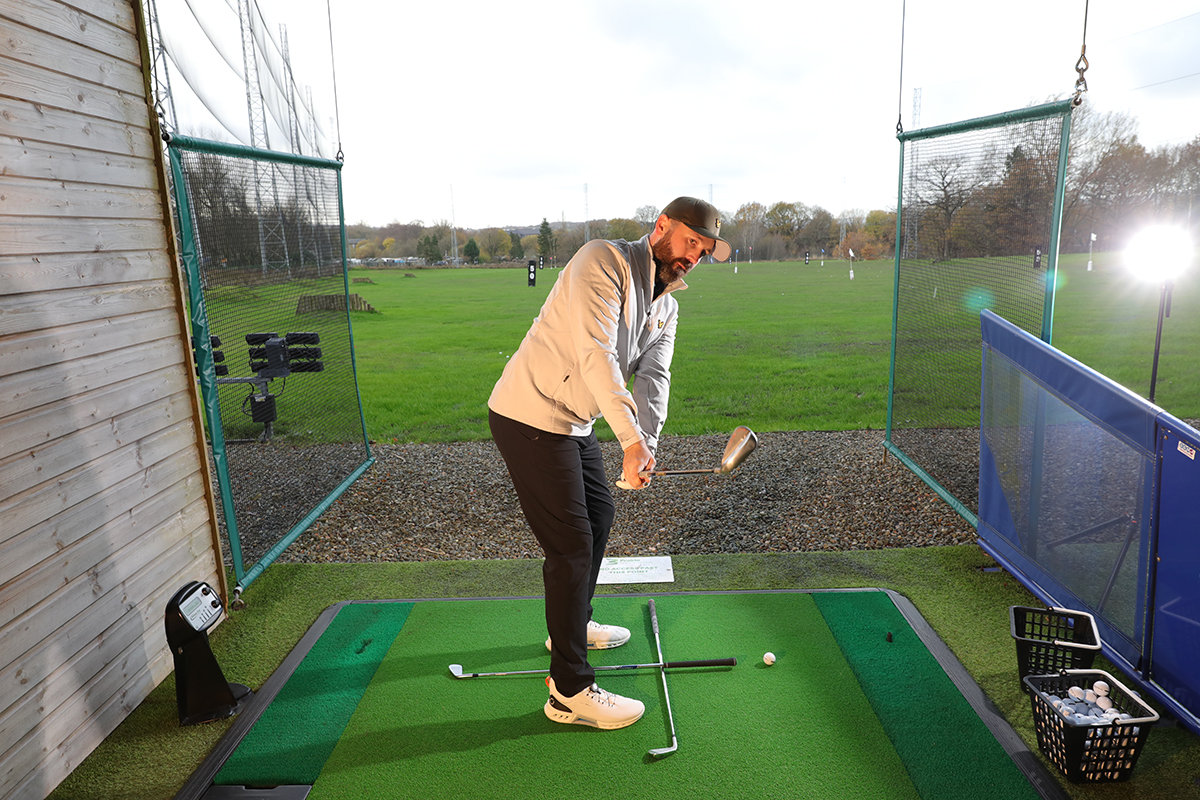
Use this setup on the range to get into good alignment habits
Section 2: Skills Challenges
The key here is to work on things you are currently not happy with in your game. Anyone can turn up and practice the things they are good at to feel better about themselves, but focus here on what you want to improve.
I like to practice from 100 yards and in, hitting 10 shots and trying to make each one go marginally further than the last. You can do this by eye, or use the technology available at your local driving range, but this is a great way to dial in your distances for those tricky approach shots.
I also like to work on my ‘fairway finder’, perfecting an invaluable shot that I can use each and every round on the course when required. Use flags, signs or even a cluster of balls on each side of the range to draw out an imaginary fairway in your mind. Take another 10 balls and see how many you can hit onto the ‘fairway’, record your score and try to beat it next time.
This shot isn’t about going all out with the big stick, instead take some speed and power off with a strong focus on hitting your intended target.

Adding pressure to your practice is a great way to transfer your progress to the golf course
Section 3: Pressure Practice
Finally, let’s finish things off with a little pressure. Head-to-head challenges are great if you are going to the range with someone else, or you could always create a log on your phone of your previous scores in a set of challenges and try to beat your previous performance.
Try to target a number of areas of the game by switching up the challenges. You could go for a longest drive competition, a nearest the pin or even a putting challenge on the practice green.
Take it seriously like you would on the golf course, because that way you can learn to play shots under pressure and directly convert those experiences to better performances on the golf course.

Baz joined Golf Monthly in January 2024, and now leads the instruction section across all platforms - including print and digital. Working closely with Golf Monthly's Top 50 Coaches, he aims to curate and share useful tips on every aspect of the game - helping amateurs of all abilities to play better golf. Baz also contributes weekly to the features section, sharing his thoughts on the game we love and the topics that matter most. A member at Sand Moor Golf Club in Leeds, he looks forward to getting out on the course at least once a week in the pursuit of a respectable handicap.
Baz is currently playing:
Driver: Benross Delta XT
3-Wood: Benross Delta XT
Hybrid: TaylorMade Stealth 4 Hybrid
Irons: Benross Delta XT 5-PW
Wedges: TaylorMade RAC 60, Callaway Jaws MD5 54
Putter: TaylorMade Spider Tour
- Anders MankertMaster PGA Professional and Golf Monthly Top 50 Coach
- Dan GrieveTop 50 Coach
- Rick ShielsTop 50 Coach
You must confirm your public display name before commenting
Please logout and then login again, you will then be prompted to enter your display name.